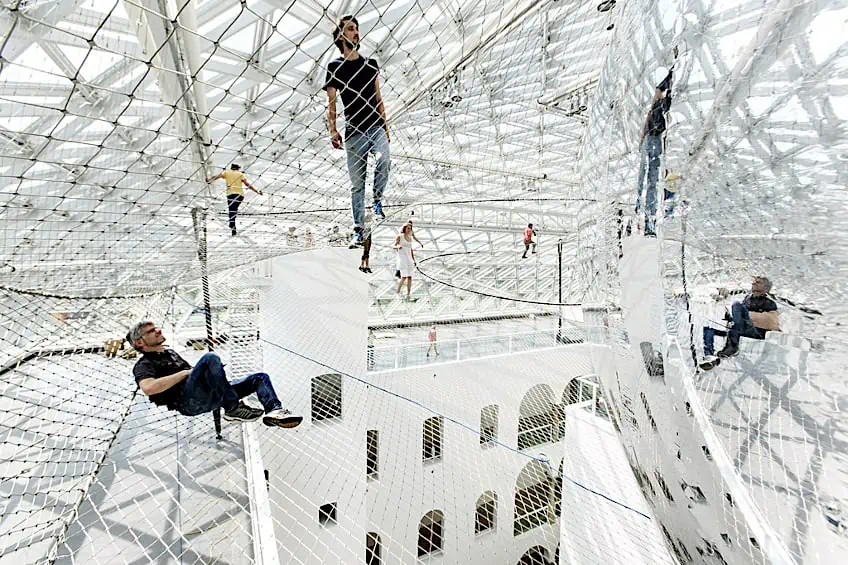What Is 3D Art? – Types of Three-Dimensional Artwork
What is 3D art? We encounter the third dimension every day, but in art, three-dimensionality helps add an extra sense of depth and sometimes ephemeral meaning to seemingly common themes and subjects. Two-dimensional art is based on the format of a flat plane with set boundaries where an artist creates of an illusion of space, or a surface where artists engage with formal elements. By contrast, three-dimensional art activates, occupies, or can seem to occupy, the same physical space as the viewer. In this article, we will look at the meaning of various types of 3D art, including how the three-dimensional effect is achieved, a few popular contemporary 3D artists, and the difference between two-dimensional and three-dimensional art.
Contents
- 1 The Third Dimension
- 2 Famous 3D Artworks
- 2.1 Le Baiser (1882) by Auguste Rodin
- 2.2 Statue of Liberty (1886) by Frédéric Bartholdi
- 2.3 Accumulation No. 1 (c. 1963) by Yayoi Kusama
- 2.4 Copan (2002) by Andreas Gursky
- 2.5 Everydays Series (2007) by Beeple
- 2.6 In the Sound (2012) by Shintaro Ohata
- 2.7 Dies Irae (2012) by Kurt Wenner
- 2.8 Digital Revival; Living Series (2022) by Fvckrender
- 3 Frequently Asked Questions
The Third Dimension
What is 3D art? Simply put, three-dimensional art generally occupies physical space and requires the viewer to engage with it spatially from different angles, or it is two-dimensional art that creates an unusually convincing illusion of space. In digital and imaging terms, 3D art can also defined as an “anaglyph” that is an effect created by layering a red and cyan-colored filter on an image to produce the 3D effect you see in cinemas.
Three-dimensional artforms generally fall within the realm of sculpture, but can include photography, painting, and art created with digital software that aid 3D artists in creating digital artworks that present abstract concepts.
 Maman or Mother Spider by Louise Bourgeois (1999) in front of the Palacio de Bellas Artes in Mexico City; AlejandroLinaresGarcia, CC BY-SA 3.0, via Wikimedia Commons
Maman or Mother Spider by Louise Bourgeois (1999) in front of the Palacio de Bellas Artes in Mexico City; AlejandroLinaresGarcia, CC BY-SA 3.0, via Wikimedia Commons
When forming a 3D art definition, it is useful to understand what the third dimension comprises. In contrast to two-dimensional art, 3D art occupies the same physical space or appear to occupy the same physical space as the viewer.
Most types of 3D art is designed to be viewed and interpreted from multiple angles. Different effects and techniques can be leveraged to achieve this and include the use of sculptural methods such as carving, modelling, and construction that to define form, volume, and mass in various materials.
In the case of creating 3D illusions, artists will use perspective, technology, light and shadow, and a combination of methods to essentially model an object that occupies space, has height, weight, depth, and casts a shadow, thereby creating an illusion of a real-world object.
 Escaping Criticism by Pere Borrell del Caso (1874); Pere Borrell del Caso, Public domain, via Wikimedia Commons
Escaping Criticism by Pere Borrell del Caso (1874); Pere Borrell del Caso, Public domain, via Wikimedia Commons
How Does One Create 3D Art?
Three-dimensional art can present itself in different forms, as mentioned in the introduction above. The easiest way to grasp the essence of 3D art is to turn to sculpture and the idea of constructing an object or artwork that “has a body”, “seems real”, and “appears to occupy physical space”. But before we dive into sculpture and its role in 3D art, let us examine the ways that 3D art can be achieved.
Drawing and Three-Dimensionality
Drawing is perhaps the first medium through which many artists first discover the potential for the development of 3D art. In the drawing, the use of perspective techniques will be required to create the illusion of a 3D object and artificially present the illusion of depth, light, shadow, and all of the elements of a physical 3D artwork, such as a sculpture, in the real world.
Creating texture in drawing is one way in which an artist can allude to a sense of weight.
 Drawing of foreshortened or Trompe L’Oeil View of the Architecture Surrounding a Courtyard (between 1657 and 1743); Ferdinando Galli-Bibiena, CC0, via Wikimedia Commons
Drawing of foreshortened or Trompe L’Oeil View of the Architecture Surrounding a Courtyard (between 1657 and 1743); Ferdinando Galli-Bibiena, CC0, via Wikimedia Commons
2D vs. 3D
When drawing, one usually starts by drawing two-dimensional marks on paper that make an object visible to us, yet it does not give us a sense of real dimension. 2D art contains flat shapes and figures that are limited to a 2D structure and do not include height but rather length and breadth. It can be thought of as drawing the shape of a square on a page but not as a cube, which would be the entire structure of an object from multiple angles.
2D figures and objects are also referred to as plane shapes and plane figures. 2D objects do not carry any volume since the shape is restricted. On the other hand, a three-dimensional structure consists of three surfaces and is based on three axes, namely the X-axis, the Y-axis, and the Z-axis.
 Holographic Interface by Beeple/Michael Joseph Winkelmann (2014) consists of various 2D bars and labels projected into space to create a layered 3D effect; beeple, CC BY 4.0, via Wikimedia Commons
Holographic Interface by Beeple/Michael Joseph Winkelmann (2014) consists of various 2D bars and labels projected into space to create a layered 3D effect; beeple, CC BY 4.0, via Wikimedia Commons
Sculpture and Installation
Sculpture is one of the most easily recognizable forms of 3D art that encapsulates three-dimensionality through its physicality. All sculptures occupy space and therefore form part of the genre of 3D art. Sculptures can also become part of assemblages and installations that also aid in expanding the notion of a 3D art experience.
Installations elevate the experience of art by creating either an interactive or immersive environment that heightens the sense of being within a space and interacting with objects within it.
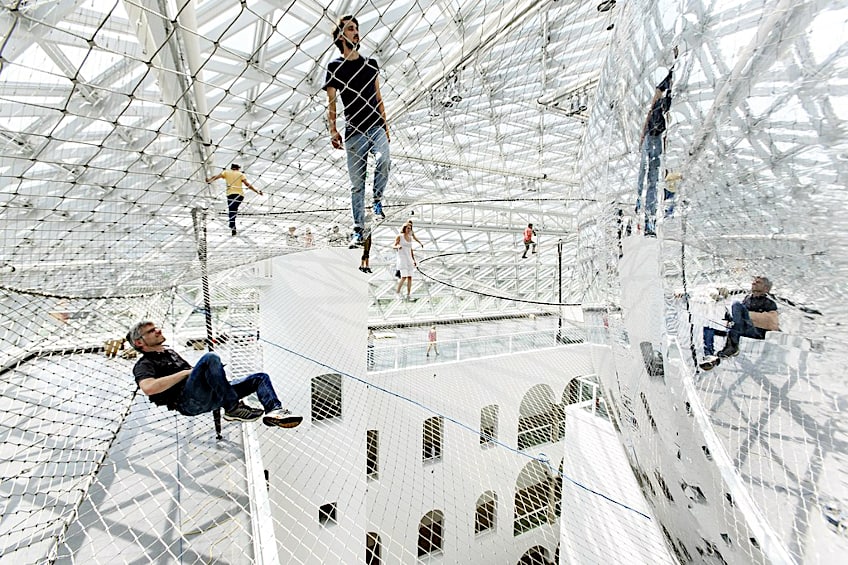 Installation view of In Orbit at K21, Düsseldorf by Tomás Saraceno (2013); STS press, CC BY-SA 4.0, via Wikimedia Commons
Installation view of In Orbit at K21, Düsseldorf by Tomás Saraceno (2013); STS press, CC BY-SA 4.0, via Wikimedia Commons
Trompe l’oeil
The genre of Trompe l’oeil also known as illusionistic painting is also an interesting arena to explore since it employs various painting techniques that can deceive the viewer into believing that they are looking at actual objects in space.
Painting techniques in three-dimensional paintings add an uncanny sense of verisimilitude to the artwork. Popular painting techniques applied to create three-dimensional paintings include chiaroscuro methods, as well as the use of linear and atmospheric perspective.
This technique only works if the artist is capable of achieving very high degrees of realism, and have established the ideal viewpoint from which to view the artwork. Unlike other forms of 3D art, 3D painting requires a static audience.
 Mana Nalu Trompe L’oeil Mural by John Pugh, Honolulu, Hawaii; John Pugh, CC BY-SA 4.0, via Wikimedia Commons
Mana Nalu Trompe L’oeil Mural by John Pugh, Honolulu, Hawaii; John Pugh, CC BY-SA 4.0, via Wikimedia Commons
Three-Dimensional Photography
Three-dimensional photography refers to the act of adding three dimensions to 2D images to add a sense of depth to otherwise flat images. To create a 3D image, one can photograph an object from two different angles to alter the viewer’s perception of depth.
The art of creating 3D images using photographs dates back to the 19th century when images of tourist destinations were particularly popular.
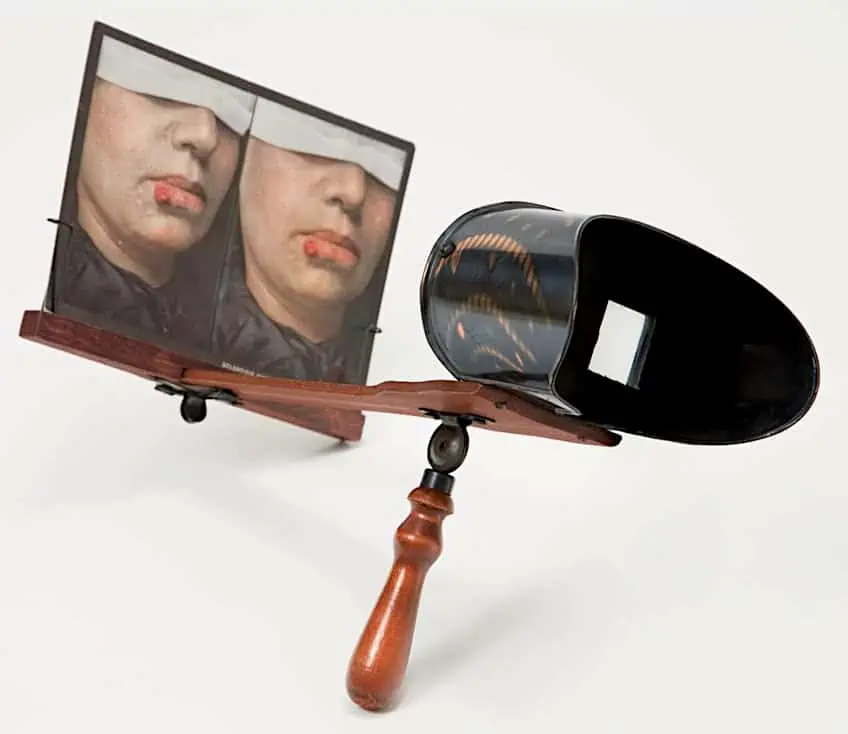 Handheld stereoscope with medical stereoscopic images; National Library of Medicine – History of Medicine, No restrictions, via Wikimedia Commons
Handheld stereoscope with medical stereoscopic images; National Library of Medicine – History of Medicine, No restrictions, via Wikimedia Commons
3D Computer Graphics
One might also wonder if graphic arts could also qualify as 3D art, especially since many people perceive 3D art to be physically rendered artwork. 3D computer graphics can be seen as a digital medium that is used to render either 2D or 3D images.
Artists who work with graphic software can also use a 2D environment to create 3D artwork. 3D art can also find itself in visual effects in movies that often begin as preliminary sketches and are then recreated as virtual reality.
Artists can also develop a computer-generated rendering of a digital artwork, which can become a sculpture via 3D printing technology, and then send the artwork or mold to an expert called a “finisher”.
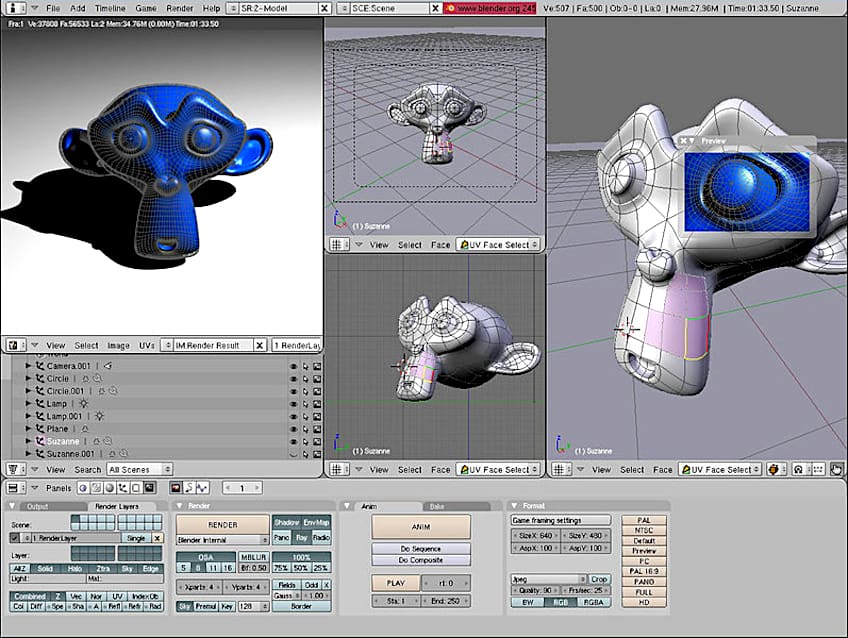 Example of software used to create 3D digital art: Screenshot of Blender 2.45 with 3D image of “Suzanne” under construction (2007); Ausis, GPL, via Wikimedia Commons
Example of software used to create 3D digital art: Screenshot of Blender 2.45 with 3D image of “Suzanne” under construction (2007); Ausis, GPL, via Wikimedia Commons
Famous 3D Artworks
Visualizing various examples of three-dimensional art is the best way to answer your question “what is 3D art?”. From artists such as Gian Lorenzo Bernini to Yayoi Kusama, 3D art has been visualized through many stunning mediums and creative approaches. Below, we will look at the most popular 3D artworks from around the world.
Le Baiser (1882) by Auguste Rodin
| Artist | François Auguste René Rodin (1840 – 1917) |
| Date | 1882 |
| Medium | Marble and bronze |
| Dimensions (cm) | 182 x 112 x 117 |
| Where It Is Housed | The National Museum of Western Art, Tokyo, Japan |
Le Baiser is a famous classical 3D sculpture by none other than the sculpture master Auguste Rodin. The sculpture, translated in English as “the kiss”, is one of Rodin’s most recognized artworks that illustrates a couple embracing one another.
The statue was initially meant to form part of Rodin’s other sculpture The Gates of Hell (1880-1917), but the romantic statue was so at odds with the tormented figures of doomed souls in hell, that it had to remain a work of its own. The 3D sculpture is famous for not only its title but its embodiment of passion and desire born out of love.
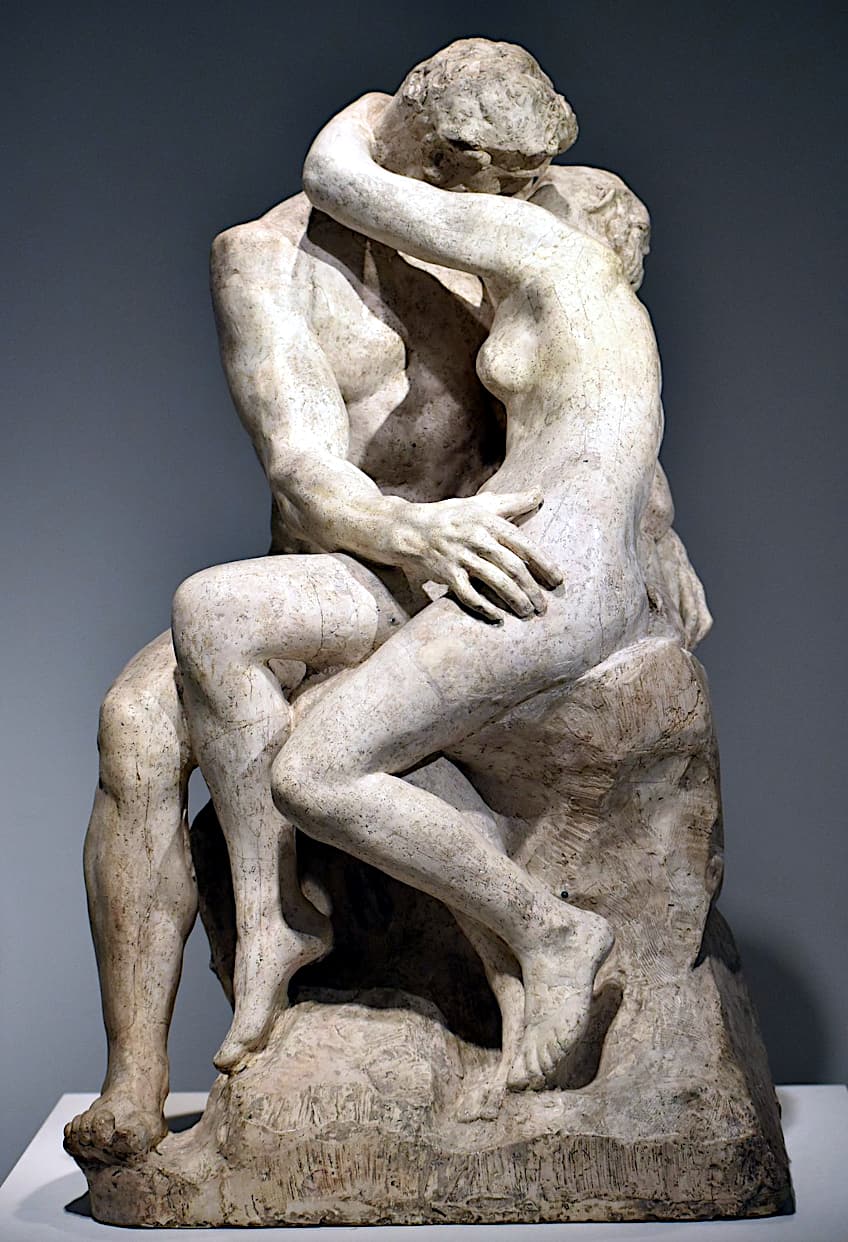 The Kiss or Le Baiser by Auguste Rodin (1882); Tylwyth Eldar, Public domain, via Wikimedia Commons
The Kiss or Le Baiser by Auguste Rodin (1882); Tylwyth Eldar, Public domain, via Wikimedia Commons
Statue of Liberty (1886) by Frédéric Bartholdi
| Artist | Frédéric Auguste Bartholdi (1834 – 1904) |
| Architect(s) | Richard Morris Hunt (1827 – 1895) and Alexandre Gustave Eiffel (1832 – 1923) |
| Date | 1886 |
| Medium | Copper, gold, steel, and cast iron |
| Dimensions (m) | 93 (h) |
| Where It Is Housed | New York City, United States |
The Statue of Liberty is one of the most famous examples of 3D art situated in the big apple. The massive 93-meter-high sculpture is one of the most iconic sculptures in the world, designed and sculpted by Frédéric Auguste Bartholdi and architect Richard Morris Hunt.
The Statue of Liberty maintains its signature green color due to the oxidization of the copper, which experts believe is unusually pure.
This 3D artwork was originally a gift from France with the torch of the statue initially copper until it was replaced with a glowing 24-carat golden torch, which gleams from a distance.
 Statue of Liberty or Liberty Enlightening the World by Frédéric Auguste Bartholdi (1886); Ad Meskens, CC BY-SA 3.0, via Wikimedia Commons
Statue of Liberty or Liberty Enlightening the World by Frédéric Auguste Bartholdi (1886); Ad Meskens, CC BY-SA 3.0, via Wikimedia Commons
Accumulation No. 1 (c. 1963) by Yayoi Kusama
| Artist | Yayoi Kusama (1929 – Present) |
| Date | c. 1963 |
| Medium | Sewn and stuffed fabric, wood chair frame, and paint |
| Dimensions (cm) | 87.2 x 98.9 x 92.2 |
| Where It Is Housed | Whitney Museum of American Art, New York City, United States |
Yayoi Kusama is one of the most famous 3D artists whose creative approach to sculpture elevates our perception of how 3D art can be realized. Accumulation No. 1 is a 3D sculpture of an armchair with many protrusions.
The soft protrusions appear like coral structures from the Earth and deal with Kusama’s self-reflection on sexuality and a fear of sex.
The monochromatic white color reinforces concepts of unity across the chair as a sculptural form while the combination of paint and sculpture as two separate mediums demonstrates the way that sculpture can be enhanced to create interesting 3D works.
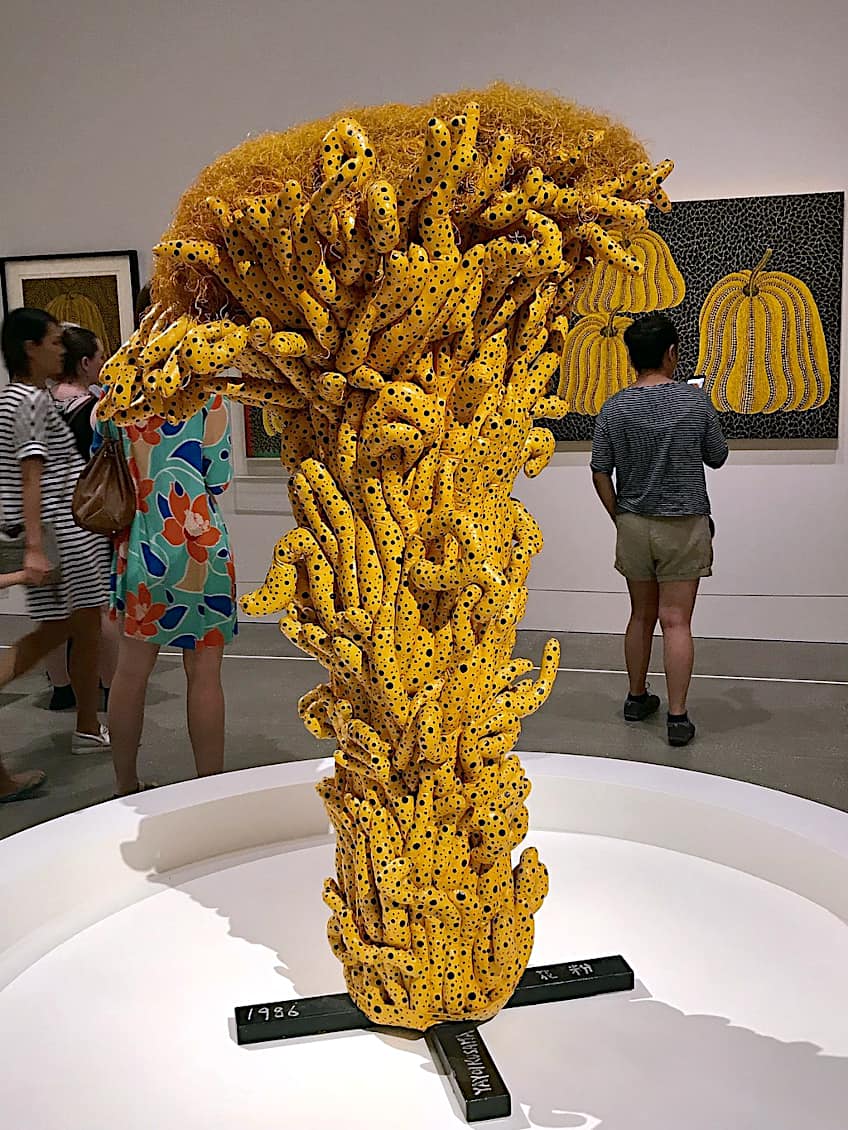 The protrusions used in Accumulation No.1 has become a recurring theme in Yayoi Kusama’s subsequent work as can be seen in Pollen (1986); Kgbo, CC BY-SA 4.0, via Wikimedia Commons
The protrusions used in Accumulation No.1 has become a recurring theme in Yayoi Kusama’s subsequent work as can be seen in Pollen (1986); Kgbo, CC BY-SA 4.0, via Wikimedia Commons
Copan (2002) by Andreas Gursky
| Artist | Andreas Gursky (1955 – Present) |
| Date | 2002 |
| Medium | Chromogenic print |
| Dimensions (cm) | 237.5 x 301.5 x 6.2 |
| Where It Is Housed | Private collection |
Copan by Andreas Gursky is an example of a 3D photograph that portrays the towering three-dimensionality of a building and its spectacular architecture. Gursky often focuses on the subject matter with detailed architecture and landscapes. The realistic manner in which Gursky presents the image of the building brings to life a sense of magnanimity.
Gursky manipulates his images by magnifying the grandiosity of nature and thus mimics an approach seen in 19th-century landscape paintings. Gursky captures his images from an elevated vantage point and fuses multiple images of the same shot. The result is a Surreal yet realistic landscape that pulls in the viewers’ attention and delivers an alternative view of reality.
Everydays Series (2007) by Beeple
| Artist Name | Beeple (Michael Joseph Winkelmann; 1981 – Present) |
| Date | 2007 |
| Medium | Digital drawing |
| Dimensions (cm) | Unavailable |
| Where It Is Housed | Unavailable |
The Everydays series is a 5000-day project initiated by a 3D artist known as Beeple who resolved to create artwork every day from 2007. The artist was so dedicated to creating art every day that he even produced work on days that were incredibly “inconvenient”.
According to sources, the project was inspired by Tom Judd and was a strategy that the artist, whose real name is Michael Winkelmann, used to hone his artistic skills in different mediums.
 Everydays – july 2016 1 by Beeple/ Michael Joseph Winkelmann (2016); Mike Winkelmann, CC BY 4.0, via Wikimedia Commons
Everydays – july 2016 1 by Beeple/ Michael Joseph Winkelmann (2016); Mike Winkelmann, CC BY 4.0, via Wikimedia Commons
The series portrays dystopian scenes and was made using software such as Adobe Illustrator and Cinema 4D. Beeple is one artist that rose to fame almost overnight after selling an NFT artwork for $69 million.
Beeple is credited with being the founder of the Everyday movement and has posted his creations almost every day for the last decade.
In the Sound (2012) by Shintaro Ohata
| Artist Name | Shintaro Ohata (1975 – Present) |
| Date | 2012 |
| Medium | Acrylic and foam on canvas |
| Dimensions (cm) | 116.7 x 116.7 x 54 |
| Where It Is Housed | Private collection |
Shintaro Ohata is a Contemporary artist who creates 3D paintings that express a sense of solitude as seen in In the Sound. Using acrylic paint and foam on canvas, Ohata blurs the lines between painting and sculpture to produce some of the most contemplative paintings that help you escape into a relatable world.
The color palette of his work is often subdued and offers a calming view of reality while evoking the three-dimensionality of painting and how it can be achieved alongside the sculpture.
Dies Irae (2012) by Kurt Wenner
| Artist | Kurt Wenner (1958 – Present) |
| Date | 2012 |
| Medium | Site-specific street painting |
| Dimensions (cm) | Unavailable |
| Where It Is Housed | Geneva, Switzerland |
This fascinating 3D street art painting is one way that follows the natural man-made architecture of the world while presenting an alternate way of viewing art. Dies Irae is a street artwork that was based on a 13th-century poem. The painting was created by famous American 3D street artist Kurt Wenner who has left his creations for many to marvel at, including internationally in Italy.
Wenner also possesses a history of collaboration with NASA, operating as a scientific space illustrator. He left NASA in 1982 and switched over to pursue his interest in Renaissance Classicism.
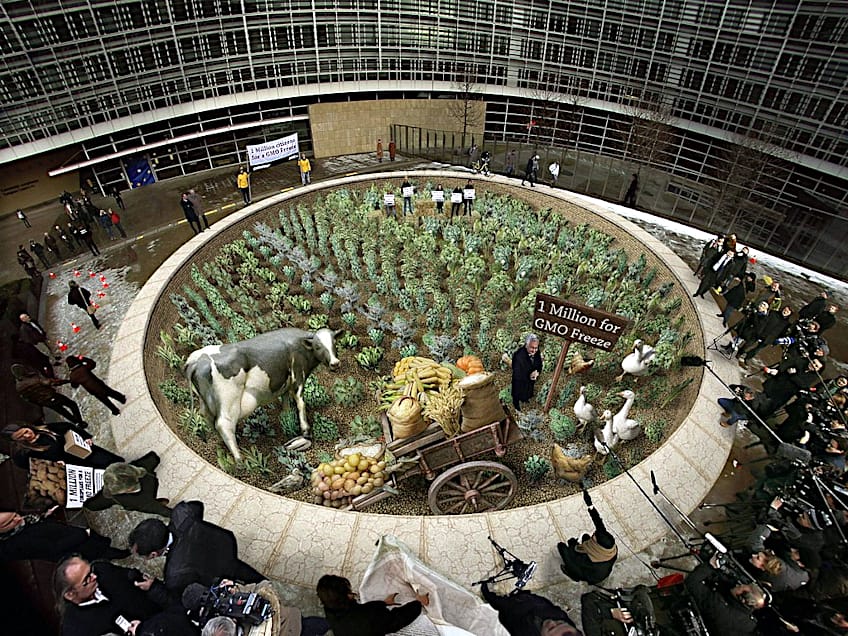 3D image created by Kurt Wenner in 2010 to commemorate Greenpeace presenting the European Union members in Brussels with a petition to ban genetically modified crops; Kurt Wenner, CC BY-SA 4.0, via Wikimedia Commons
3D image created by Kurt Wenner in 2010 to commemorate Greenpeace presenting the European Union members in Brussels with a petition to ban genetically modified crops; Kurt Wenner, CC BY-SA 4.0, via Wikimedia Commons
Digital Revival; Living Series (2022) by Fvckrender
| Artist | Frederic Duquette (n.d.- Present) |
| Date | 2022 |
| Medium | MP4 Video; NFT |
| Dimensions (res) | 1080 x 1350 |
| Where It Is Housed | SuperRare platform |
Fvckrender is currently one of the most famous 3D artists who creates stunning crystalline-like 3D artworks. Fvkrender is a self-taught artist who uses Cinema 4D software to produce 3D artworks based on futuristic landscapes. Digital Revival is one such NFT artwork that illustrates his skill in working with geometric shapes and brilliant futuristic colors.
Fvckrender has also collaborated with many celebrities, including Backstreet Boys and Calvin Harris.
3D art is a genre of art that can be conceptualized and realized in a diverse array of mediums and aesthetics. 3D art not only helps reframe our perception of physicality and materiality, but it disrupts and evolves our experience of art. Innovative thinking is necessary for the advancement of 3D artworks as seen in the examples of 3D art throughout the decades above. We hope that this article has expanded your notions of what 3D art is and how it can be realized.
Take a look at our 3D art webstory here!
Frequently Asked Questions
What Is 3D Art?
Three-dimensional art, or 3D art, refers to art that contains the dimensions of width, height, and depth. 3D art also occupies space and can be viewed and interpreted from different angles and sides. The concept of a 3D artwork is also realized through mediums such as sculpture, photography, painting, installation, and digital software. Traditional forms of 3D art are recognized via traditional mediums such as sculpture, while the more contemporary forms of three-dimensional art incorporate digital tools to help create digital three-dimensional artworks, thus creating the illusion of the 3D without any physical property. In some cases, these digital artworks are turned into sculptures or 3D-printed objects.
What Is the Difference Between 2D and 3D Art?
The difference between 2D and 3D art is that 2D art is usually flat and has no real volume or height, while 3D art can present as an image that demonstrates volume and height yet also contain three dimensions, namely, the horizontal dimension, vertical dimension, and the dimension of depth. The difference between 2D and 3D art can be understood as the difference between a square and a cube.
What Are Some Three-Dimensional Art Examples?
Some three-dimensional art examples include sculptures or statues, paintings, digital artwork with 3D visual effects, and architectural design.
Jordan Anthony is a Cape Town-based film photographer, curator, and arts writer. She holds a Bachelor of Art in Fine Arts from the University of the Witwatersrand, Johannesburg, where she explored themes like healing, identity, dreams, and intuitive creation in her Contemporary art practice. Jordan has collaborated with various local art institutions, including the KZNSA Gallery in Durban, the Turbine Art Fair, and the Wits Art Museum. Her photography focuses on abstract color manipulations, portraiture, candid shots, and urban landscapes. She’s intrigued by philosophy, memory, and esotericism, drawing inspiration from Surrealism, Fluxus, and ancient civilizations, as well as childhood influences and found objects. Jordan is working for artfilemagazine since 2022 and writes blog posts about art history and photography.
Learn more about Jordan Anthony and about us.
Cite this Article
Jordan, Anthony, “What Is 3D Art? – Types of Three-Dimensional Artwork.” artfilemagazine – Your Online Art Source. February 3, 2023. URL: https://artfilemagazine.com/what-is-3d-art/
Anthony, J. (2023, 3 February). What Is 3D Art? – Types of Three-Dimensional Artwork. artfilemagazine – Your Online Art Source. https://artfilemagazine.com/what-is-3d-art/
Anthony, Jordan. “What Is 3D Art? – Types of Three-Dimensional Artwork.” artfilemagazine – Your Online Art Source, February 3, 2023. https://artfilemagazine.com/what-is-3d-art/.


